Call center metrics and key performance indicators (KPI) provide businesses with valuable insights into agent performance, the customer experience, and overall call center performance. While every metric is crucial, businesses must prioritize those that align with their needs and objectives. In this article, we explore key call center metrics and explain which will benefit your organization.
Call Center Metrics at a Glance
We’ve broken down 25 of the best call center metrics and divided them into four categories: customer experience, agent performance, call initiation, and call center operations. From here, you can differentiate and identify which metrics would impact your existing business processes.
|
Data Measured |
Contact Center Metrics |
|---|---|
|
|
|
|
|
|
|
下面我们提供一个详细的解释metric, including the formula to compute key performance indicators (KPIs) manually. When computing KPIs, use data from your contact center software,business phone system, orcustomer relationship management (CRM) system.
Customer Experience Metrics
Businesses rely more than ever on call center solutions to gain insights into whether they are providing the support customers need. This is determined by sending surveys after a voice interaction. Here are the most commonly usedcustomer experience metricsfor call centers to help evaluate the quality of yourcustomer service.
1. Customer Satisfaction (CSAT) Score
The CSAT score is one of the most important call center metrics, which tells how satisfied customers were with the support they received. When a call ends, call centers send out surveys, asking callers to rate their experience on a scale of one to five, with one being very unsatisfied and five being very satisfied.
Formula:
|
CSAT
|
=
|
No. of satisfied customers (4 and 5) |
✕
|
100% |
|
No. of survey responses |
2. First Contact Resolution (FCR)
FCR is considered the most important KPI to track as it measures agents’ ability to resolve customer queries within the first call. Basically, it determines how well you meet customer needs for the first time without the need for callbacks and transfers. You can determine FCR by asking the caller right after the call or surveying them later to know if their problem was resolved.
Formula:
|
FCR
|
=
|
Total no. of calls resolved on first attempt |
|
Total no. of calls received |
3. Net Promoter Score (NPS)
NPS determinescustomer loyaltythrough a simple survey question: “How likely would you recommend [company] to a friend or family member?” Scoring is based on a rating scale of 1 to 10, where responses are divided into three segments: promoters (9 or 10), passives (7 or 8), and detractors (6 or below). The higher the FCR, the more likely customers will recommend your business.
Formula:
NPS = %of promoters– %of detractors
4. Customer Effort Score (CES)
CES measures how much effort customers put in to get their queries resolved. It also indicates whether you’re making the calling process easier for them. This call center KPI typically uses the question, “On a scale of 1 to 5 (with 1 being very difficult and 5 being very easy), how easy is it to get your issue resolved?” A high CES indicates that customers find it easy to work with you.
Formula:
CES = %of customers who said it’s easy (4 and 5)– %of customers who said it’s difficult (1 and 2)
Pro tip:Want to achieve a higher CES? Create more customer contact options, such as live chat and self-service tools (e.g., chatbots). Discover which one works for your call center in our guide aboutchatbot vs live chat.
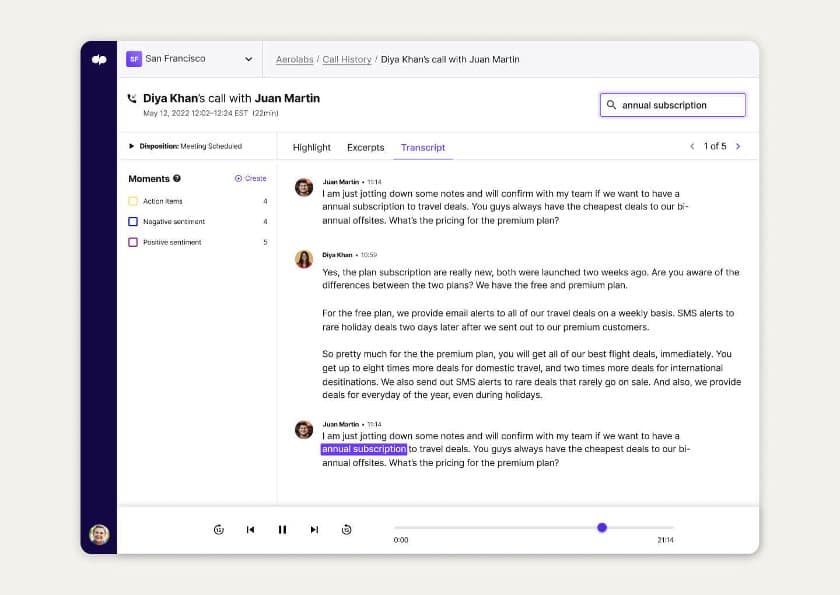
Dialpad’s call summary includes key highlights, excerpts, and a full transcript. (Source:Dialpad)
Dialpad offers an artificial intelligence (AI)-powered contact center solution that helps business users increase customer satisfaction and agent productivity. The call summary feature transcribes real-time conversations and captures key moments from a phone call, such as snippets, action items, sentiment analysis, and caller information. This data helps agents follow up on succeeding calls, eliminating the need for callers to repeat themselves. Take a look at ourDialpad reviewfor more.
Agent Performance Metrics
Agent productivity metrics track and measure the efficiency of your agents when getting tasks done. Supervisors use these KPIs to enhance agent onboarding and training, reward high performers, and coach employees needing extra coaching. Here are call center metrics that help measure agent performance:
5. Average Handle Time (AHT)
AHT is one of the standard call center metrics that measures the amount of time an agent spends on a call from the initial contact to the final solution. Longer AHTs might mean that agents don’t have the skills or tools to properly handle customer issues, while those who routinely exceed AHT benchmarks might rush through calls without fully addressing the customer’s needs. The idea is to create the best outcome possible in the least amount of time.
Formula:
|
AHT
|
=
|
(Total talk time+Total hold time+Total after-call work time) |
|
Total no. of calls |
6. Average Time in Queue
This call center KPI refers to the average time a caller spends waiting before they are connected with an agent. In this case, the lower the number, the higher the chances of increasing customer satisfaction scores and lowering your abandonment rate.
Formula:
|
Average time in queue
|
=
|
Total time a caller waited in the queue |
|
Total no. of answered calls |
7. Average Speed of Answer (ASA)
ASA refers to the average time a call remains in a queue until an agent responds. A higher ASA can mean that agents take longer on calls, potentially increasing the risk of callers hanging up. Measuring ASA helps evaluate whether your agents need more coaching, guidance, or training.
Formula:
|
ASA
|
=
|
Total wait time for answered calls |
|
Total no. of answered calls |
8. Agent Utilization Rate (AUR)
AUR evaluates agent productivity by examining how agents use their time throughout their shifts. It represents the total percentage that agents spend on handling calls and other call-related tasks during their designated work hours. Ideally, AUR should be between 70% to 75%. A low AUR indicates that a call center is overstaffed, while an extremely high AUR could mean that agents are more likely to rush calls, leading to burnout and errors.
Formula:
|
AUR
|
=
|
(Average number of calls handled x Average handle time) |
✕ |
100% |
|
Total designated work hours |
9. Average Call Transfer Rate
The average transfer rate monitors how often agents transfer inbound calls to another agent or department. While call transfers are unavoidable, call centers should keep them at a minimum to avoid frustrating customers. Higher transfer rates indicate a problem with your call flow and agent skill set. These require reworking your menu options and providing cross-departmental training for agents to answer inquiries better.
Formula:
|
Transfer rate
|
=
|
(
|
Total no. of transferred calls |
)
|
✕
|
100% |
|
Total no. of handled calls |
10. Call Availability
Call availability determines how often agents are available to take calls and how long they take to close inquiries. It provides companies insights into a call center’s peak hours and lull periods, which helps adjust agents’ work shifts. This metric also indicates whether agents are sticking to their schedules. In this case, if the call availability is surprisingly low, managers should investigate if several agents are absent or if there is a high volume of calls.
Formula:
|
Call availability
|
=
|
(
|
Total time spent on waiting for calls |
)
|
✕
|
100% |
|
Total logged time |
11. Average Call Occupancy Rate
Occupancy rate is the percentage of time agents spend on call-related activities. If occupancy rates are low, your agents might spend time on tasks that are not call-related, resulting in counterproductivity. A higher occupancy rate, on the other hand, means agents have less time between calls, which leads to burnout. An occupancy rate of 85% to 90% is a reasonable goal to target.
Formula:
|
Occupancy rate
|
=
|
(
|
总电话处理时间 |
)
|
✕
|
100% |
|
Total logged time |
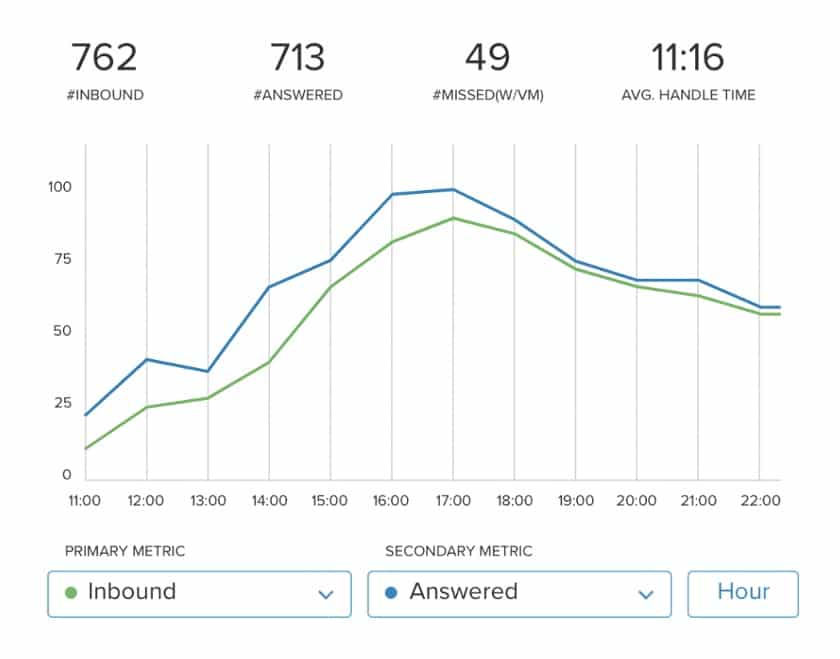
RingCentral lets you use different filters to configure the AHT data you see in your dashboard. (Source:RingCentral)
RingCentral is a call center phone system with customizable dashboards and real-time insights. It features average handle time analysis to help you monitor the time spent on the interactive voice response (IVR), call queue, and live talk. Having this data available provides a clear view of which areas your agents should improve. For more on RingCentral’s contact center offerings, check out ourRingCentral review.
Visit RingCentral Contact Center
Call Initiation Metrics
Customers’ perception of your business starts when they initiate contact with your contact center. They are judging the length of wait times before they get to speak to an agent and how you engage with them. Here are all center metrics to track to determine the effectiveness of your call center team in receiving calls:
12. Active Waiting Calls
这个呼叫中心指标显示你的团队如何handles call volume by tracking the number of calls waiting to connect. It provides real-time insights into the number of calls handled versus those on hold. A higher rate of active waiting calls typically results in poor customer experience and lowercustomer retention.
Formula:
|
Percentage of active waiting calls
|
=
|
(
|
No. of calls on hold |
)
|
✕
|
100% |
|
Total no. of calls |
13. Average Call Abandonment Rate
Abandonment rate is one of the most common call center metrics for evaluating customer service. It shows the percentage of callers who hang up before reaching a live agent. An abandonment rate of 5% to 8% is considered acceptable, and anything above that indicates delayed response times from agents.
Use the formula below or try our free online calculator tocompute your call abandonment rate.
Formula:
|
Abandonment rate
|
=
|
(
|
Number of calls—处理的电话 |
)
|
✕
|
100% |
|
Number of calls |
14. Average Hold Time
There are instances when agents have to place callers on hold to access information about the customer, speak with a manager, or research the caller’s issue. This call center KPI measures the average time spent putting callers on hold. While hold times are inevitable, agents should keep the hold time as short as possible.
Formula:
|
Average hold time
|
=
|
Total time customers spend on hold |
|
Total no. of calls |
15. First Response Time (FRT)
FRT measures the time an agent takes to respond to a customer inquiry. While it is often confused with ASA, FRT focuses on the time a customer must wait before connecting with an agent. The lower the FRT, the more callers are satisfied with the call experience, while a higher FRT indicates issues with staffing needs and technologies used.
Formula:
|
Average FRT
|
=
|
Total of all first response times |
|
Total no. of calls |
16. Service Level
Service level refers to a call center’s ability to answer a certain number of calls in a given time frame. An example of a service level standard would be responding to 80% of calls within 20 seconds. Measuring the service level helps manage customer expectations, particularly how easy it is for customers to get through.
Formula:
|
Service Level
|
=
|
(
|
Total no. of calls inntime |
)
|
✕
|
100% |
|
Total no. of calls |
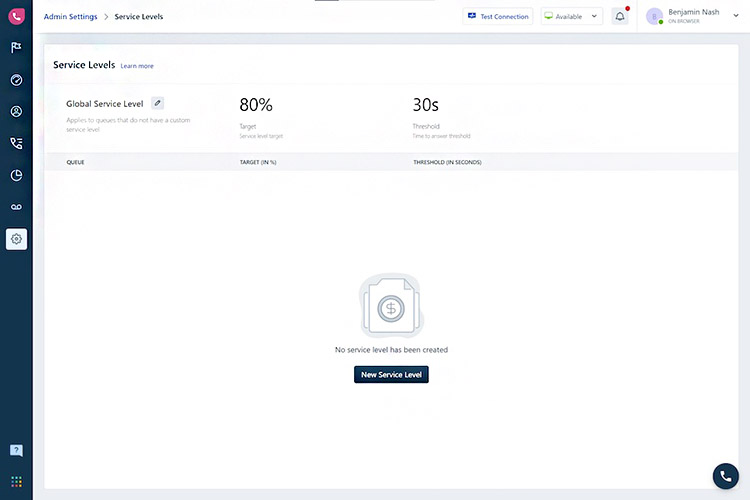
Freshdesk Contact Center lets you set a target service level within a given period. (Source:Freshdesk)
Freshdesk is a cloud-based contact center software that offers a variety of analytics tools for monitoring customer experience, quality of conversations, and team performance. One of its standout features is that it lets you configure your account’s service level. Establish the percentage of your target service level and the expected threshold time. This allows you to track if your agents are meeting the standards. Read ourFreshdesk reviewto explore its contact center offerings.
Call Center Operations Metrics
Call center performance metrics help companies monitor day-to-day operations over time. These metrics help spot call trends, identify peak times, and predict staffing needs. Below we list the most commonly used call center efficiency metrics to help you understand the level of service your teams offer.
17. Call Arrival Rate
This metric illustrates the total number of calls your call center receives within a given period. It can be expressed by minute, hour, or day, depending on which trend your team finds the most beneficial. For example, if you receive less than 100 calls daily, you may want to measure the arrival rate as calls come in per hour. Call arrival rate determines staffing needs and seasonal calling trends to decide whether to scale up your operations.
Formula:
Call arrival rate =Incoming calls per hour/minute/second
18. Average Call Length
Also called average call duration, this metric provides a full view of the average length of calls in a specific period. It includes the time the agent answers the call until it disconnects, excluding after-call tasks. Call center managers use this metric to manage team expectations and agent workflows.
Formula:
|
Average call length
|
=
|
Total time for all calls |
|
Total no. of calls |
19. Calls Handled
This metric is also referred to as the call volume trend, which measures your total inbound and outbound calls within a certain period, excluding abandoned calls. Call centers typically categorize call volume into the total calls handled by agents and an automated system. Like average call length, this metric helps optimize workforce schedules while ensuring better customer experiences.
Formula:
Call volume =Total calls handled by an agent/automated system (IVR)
20. Average Age of Query
The average age of query calculates the length of time queries remain open if they’re not addressed on the first attempt. Related to FCR, this metric helps call centers understand how long it takes to resolve outstanding queries and identify issues that lead to extended resolution periods.
Formula:
|
Average age of query
|
=
|
Total time (in hours or days) open queries stay unresolved |
|
Total no. of open queries |
21. Cost per Call (CPC)
CPC gauges the average cost of each call handled by agents, giving you a critical view of how much you spend on your call center operations and resource allocation. For every call, companies pay a specific price, which is determined by the contact center solution they’re using. From there, they set an ideal CPC to maintain a specific threshold.
Formula:
|
CPC
|
=
|
Total cost of all calls |
|
Total no. of calls |
22. Peak Hour Traffic
This metric determines specific periods in which your call center receives the highest volume of calls. Knowing the peak-hour traffic helps you allocate extra agents in advance and prepare your team for the influx of incoming calls. Note that this metric has no standard formula—simply monitor your call logs to identify the time of day you receive the most calls.
23. Repeat Call Rate
Related to FCR, the repeat call rate helps call centers determine which issues are left unresolved in the first call. Use your contact center software to document repeat callers. If the repeat call rate is high for a specific query, you may want to provide more self-service options and additional agent training.
Formula:
|
Repeat call rate
|
=
|
(
|
No. of calls related to specific issue |
)
|
✕
|
100% |
|
Total no. of calls |
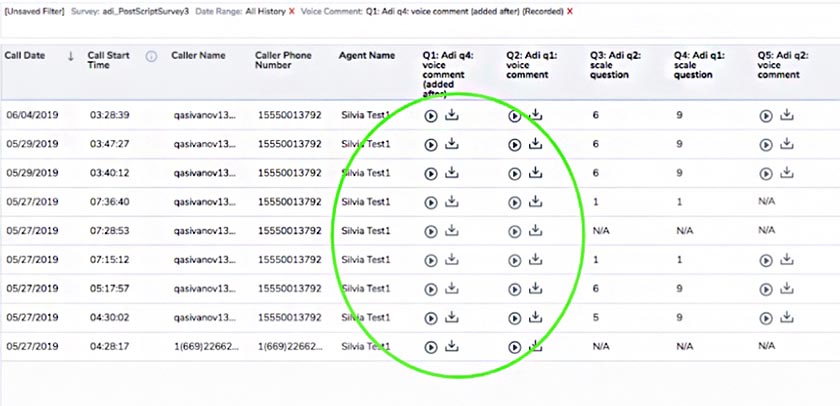
8×8 allows users to download multiple voice comments on each survey question. (Source:8×8)
Contact center systems like 8×8 allow users to present a questionnaire at the end of each call to collect feedback. The post-call survey feature by 8×8 provides IVR-controlled surveys, which are taken by callers voluntarily. Use this to gather customer feedback and determine if their query requires them to make a repeat call. Learn more by reading our8×8 Contact Center Review.
24. Percentage of Calls Blocked
When a call center is overwhelmed with calls, incoming callers may receive a busy signal due to a full call queue or lack of available agents. Blocked calls may include customers who went to voicemail and requested a callback. Finding out the percentage of blocked calls will help you identify issues with staffing levels, contact center software, and team productivity.
Formula:
|
Percentage of calls blocked
|
=
|
(
|
No. of calls that fail to reach agents |
)
|
✕
|
100% |
|
Total no. of incoming calls |
25. Callback Messaging
The callback messaging metric helps track the number of customers requesting a callback to avoid long wait times. This helps in planning staffing requirements and ensuring customers receive a callback on time. There is no specific formula for this metric, as it simply refers to the total number of callback requests for a given period.
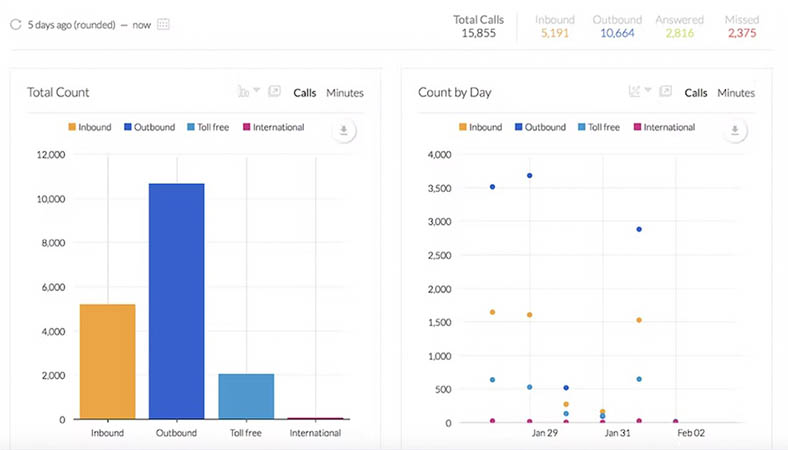
Nextiva provides a real-time overview of call center activity across your company. (Source:Nextiva)
Nextiva provides a cloud-based call center solution that uses interactive maps and graphs to break down the call analytics data you want to access. The call summary reports offer a visualized presentation of the total number of calls you received in a specified period. Find out more about all of Nextiva’s offerings in ourNextiva Review.
Check out our guide on thebest call center phone systemsto discover which provider suits your small business needs. While you’re at it, find out the most recentcontact center statisticsand get updated on the latest call center trends.
Frequently Asked Questions (FAQs)
How can call centers improve their metrics?
主要有两种方法来提高呼叫中心rics: provide comprehensive agent training and invest in contact center software. Offering agents regular training opportunities equips them with the right skill set and knowledge to deliver better customer service. Combine it with the right contact center system to take the pressure off of agents to do and know everything.
What is the difference between call center analytics & reporting?
Analytics and reporting are essential contact center features that help businesses obtain actionable insights. Call center analytics involve collecting and monitoring performance metrics and trends based on call data and agent activities. On the other hand,call center reportinginvolves visual elements to present raw data.
Are the metrics used for inbound & outbound call centers different?
Some metrics and KPIs are unique to inbound and outbound call centers. For instance, inbound call center metrics include repeat call rate, call arrival rate, and callback messaging. Outbound call centers, on the other hand, focus on metrics that help them monitor their sales targets, such as conversion rates, sales per agent, and list closure rates.
Bottom Line
Learning how to track and understand the function of each call center metric is the key to improving agent and customer experiences. That is why it’s important to evaluate your KPIs regularly and utilize the analytics and reporting features of your contact center software. Use these insights to discover new opportunities for your agents, customers, and overall call center operations.